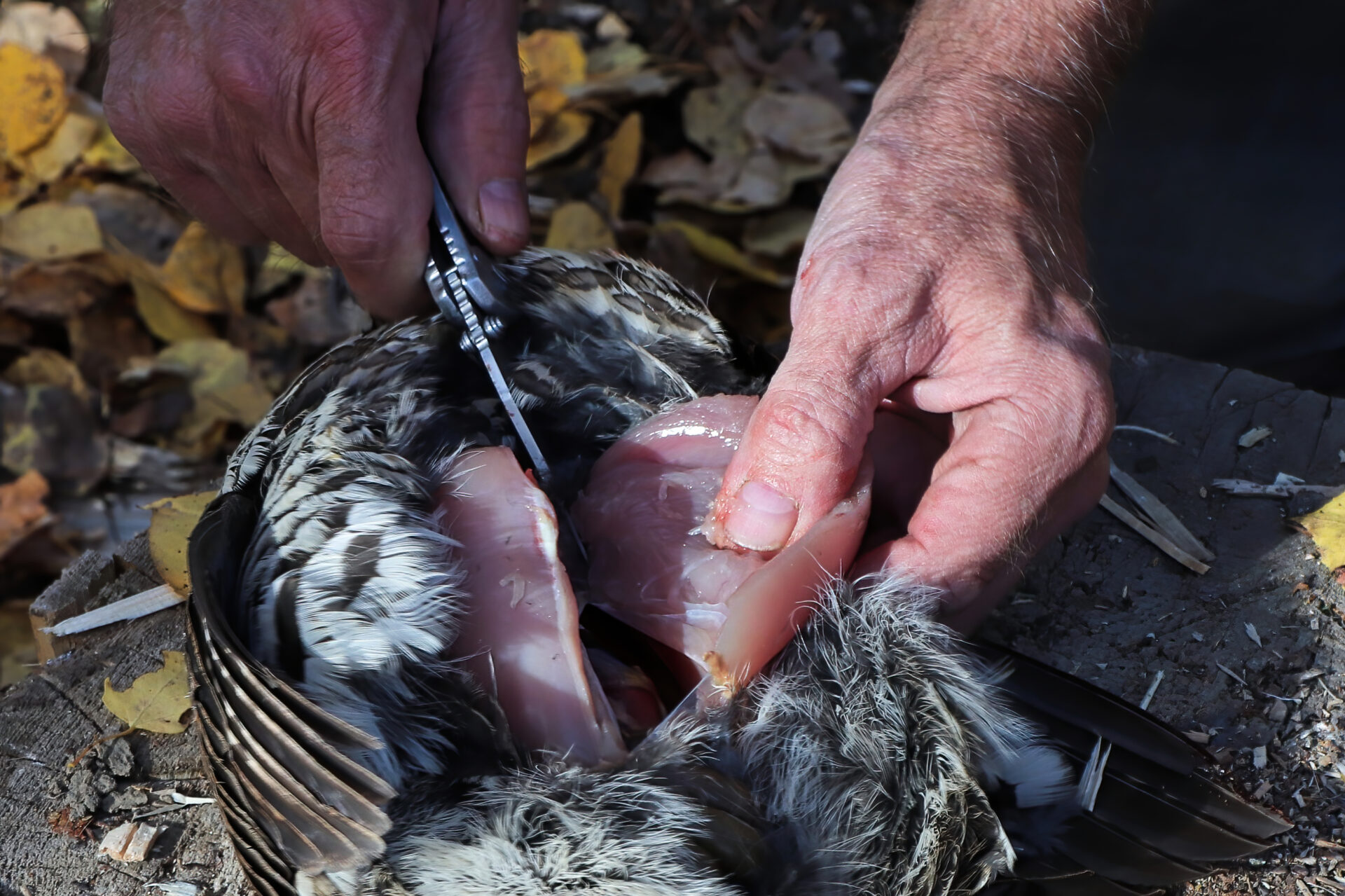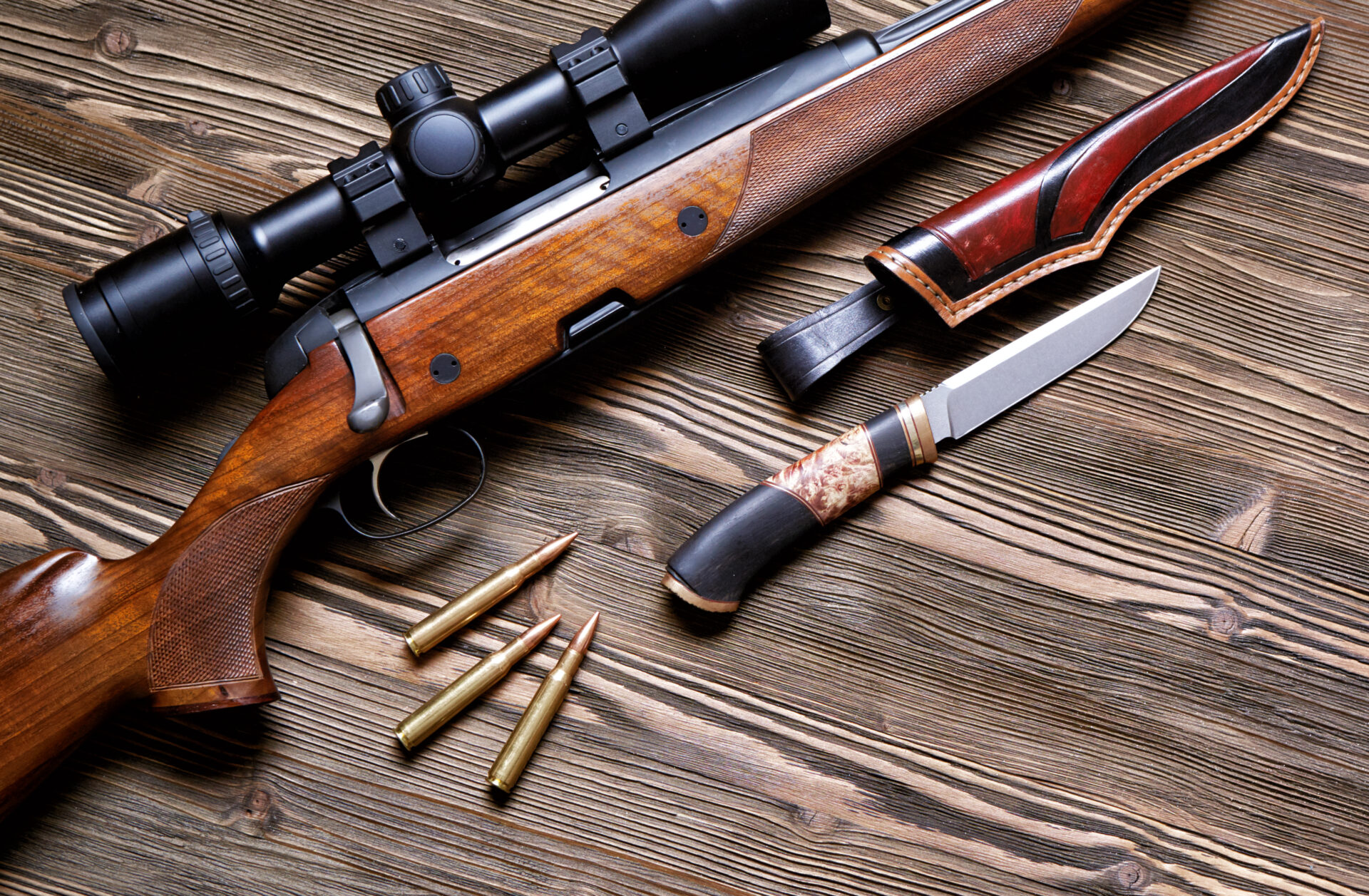From our earliest history, knives have been elemental to our survival. They were one of the first tools we developed as primitive hunters. Oldowan tools of stone chips or flakes date back 2.5 million years. These crude knives eventually evolved into knives made from copper, bronze, iron, steel and, most recently, titanium and ceramic. Knives not only assisted us in dressing, skinning and processing game, but they also became very useful tools for a multitude of purposes. I have to admit I have a thing for knives, a fact that is borne out by the sheer number I use or have accumulated over the years. Some that are custom made see little field use, but most are practical hunting knives. Today, whenever I organize an equipment list for an upcoming hunt, right behind my licenses, firearm, binoculars and ammunition is always one type of knife or another. They are essential to most any hunt and, on the rare occasion, may even save your life. The style or type is usually dictated by the hunt I’m about to embark on.
Advertisement
Knives are a rather simple tool. There are essentially two key components: a handle and a blade. While they may be simple by design, they have certainly tested the skills of those who have built them for thousands of years. While the quality of today’s knives always equates to the quality of steel used in its construction, premium steel still requires skill and craftsmanship to turn it into a fine knife. But the unanswered question for many still remains: “What makes it a good hunting knife”? It can get downright confusing, so let’s dissect their design, construction and application one step at a time.
Advertisement
What’s in the Steel
There are many grades of steel, as well as individual components, that go into these various grades. They include iron, carbon, chromium, manganese, molybdenum, silicon, vanadium, sulphur, phosphorous, nickel, tungsten and cobalt. Each and all bring various properties to the final product. For example, carbon can increase hardness, strength and abrasion resistance, while chromium improves corrosion resistance and toughness. In essence, it’s a balancing act to achieve the properties the knife builder wants. And getting it right is not necessarily a simple task, as components can vary by fractions of percent and change the final product.
Meanwhile, all the varieties of steel and steel alloys have now escalated to the point of utter confusion for the buyer. From my perspective, stainless steel that offers edge retention, sharpness, corrosion resistance and ease of sharpening is pretty much on target for a hunting knife. VG-10 steel would probably top my list, but AU-8 and the old classic 440C are decent steel. There are far too many types of steel for a comprehensive list, so do some research to be sure you are getting the type of steel you want in a knife. Hardness of steel is also rated on a scale known as the Rockwell C scale. A Rockwell C rating in the mid to high 50s (56 to 58) is preferred for most blades. Stay away from steel that is either too hard or too soft, as they will either be difficult to sharpen or won’t retain an edge.
Advertisement
I can’t leave the discussion of steel without mentioning Damascus steel. This is a folded and welded steel that creates unique patterns in the steel. In the hands of a craftsman, such a knife can become a true work of art. Just be prepared for the downward spike in your budget should you wish to purchase a premium, handmade Damascus knife. Simply put, when it comes to steel you get what you pay for. Dirt cheap hunting knives often equate to poor-quality steel.

Blade Style
While there appears to be an all but limitless number of blade styles, for the hunter there are, in reality, less than a half dozen designs that warrant analysis. Which, for simplicity, can then be further reduced to two basic types: folding and fixed. I like both, but for very different reasons.
I seldom hunt without a folding knife simply because of its compact nature. A four-inch blade on a folding knife usually equates to a maximum folded length of five inches, whereas on a fixed blade knife, you can readily double that length. That being said, when it comes to the heavy work, a folder is not as strong or as comfortable in the hand. At the end of the day, it’s a matter of personal preference and the potential job at hand. On many hunts I have carried both with different style blades for each aspect of handling game in the field. In an effort to deal with this conundrum, various knife companies have introduced multipurpose knives, such as fixed blades with a drop point and a gut hook or folding knives that come with two or more blades. Some are ingenious by design, with a typical drop point on one side and a gut bade on the other and yet others, like a swing blade, are a single blade with a drop point on one half and a gutting blade on the other that rotates through the handle. Or, alternately, others offer a number of interchangeable blades. But if you are considering a folder, ensure that it has lockable blades.
The following are practical hunting blade types.
- Drop point: The sharpened edge on this blade curves upward to meet the gentle downward slope of the back edge to form a point somewhat higher than the midpoint of the blade’s width. The back edge usually begins its mild, continuous downward curve past the midpoint on the blade, providing for a very strong point. This is a very good general-purpose blade for most hunting applications that can also double as a skinning knife blade. It would unquestionably be my first choice as a single all-purpose blade.
- Clip point: As featured in the Bowie and in many traditional hunting or pocketknives, the clip point can provide the hunter with an acceptable knife blade provided it has a short and straight clip on a robust blade. Otherwise, its longer point is its weakness, especially when looking for a first-rate, all-purpose hunting knife. A smaller clip point can also be fashioned into a quality caping knife where a longer point is required when separating the cape from a horn or antler base.
- Skinning blade: Specifically designed with its upturned point, wide blade and fine edge for skinning big game. It has little practical use beyond its intended purpose.
- Boning blade: With its longer (five to six inches), thinner and semi flex blade, it is ideal for boning out meat, especially if you are into butchering your own big game. It’s designed to move and flex around the bone, enabling the hunter to remove all the meat right down to the bone.
- Gutting blade: This is a narrow blade with a gentle upward curve toward a rounded tip that slips under the hide and paunch wall to open it without penetrating any of the internal organs.
- Multi-purpose blade: This category includes a single multi-use blade, such as one with a fine edge on the front portion of the blade for regular tasks, and a serrated edge on the rear portion of the blade for robust cutting when needed. Or it may have a gut hook on the upper tip of the blade.

Handles
Knife handle scales can be fashioned from a prestigious list of materials that may include everything from exotic wood to petrified mammoth tooth. The possibilities are almost limitless and for the most part can be of personal preference. But handles, beyond their aesthetic appeal, form a very important component in any knife. They are your contact with the knife and, as such, should be comfortable and safe to hold. This is one of the design features where a fixed blade can better a folding blade. I must admit that I’m not partial to knives with metallic handles, particularly folding knives without a finger guard, as once they get wet with blood, they become slippery and difficult to hold. Here is where I much prefer a handle made of a non-slip material, such as rubberized TPR. I mustn’t have been the only hunter out there with this concern, as in recent years a growing number of folding knife manufacturers have improved both their knives’ ergonomics and handle material. Fixed blades are also frequently designed with a finger guard of some nature to protect the hand from slipping down onto the blade and, when dealing with a sharp knife, both these features can prevent a nasty cut. The handle is an important feature, so be sure you are satisfied with not only the aesthetics, but also the fit and feel for you, the user. And, last, if given the choice on colour, for purely practical reasons of finding knives, particularly folding knives once they have been laid down somewhere, I would opt for blaze orange.
Size
There are essentially three factors to consider when looking at what size of knife to obtain. They are the intended use, length of blade and size of handle. A boning knife, for example, would require a longer blade than a general-purpose knife. But rather than spending an inordinate amount of verbiage discussing all potential uses, it is my view that a drop point blade of around four inches and a handle that leaves a small gap on either side of your hand is prefect for most applications. With a knife of this size, I have field dressed, skinned and dismantled many a big game animal.

Custom Knives
Custom knives offer you the opportunity to have a custom maker build you a knife to your exact specifications. Which means that you can not only select the steel, but also the style of blade and type of handle. Maybe you just want a collectable, or you may have an itch, as I did, for a special design that meets a specific field application need. I presently have three such knives: one, a general-purpose drop point with sheep horn handle scales; another, a skinning knife with water buffalo horn handle scales; and the last, a caping knife with hippo ivory handle scales. If the knife maker is worth their salt, these knives won’t come cheap, so plan accordingly and make sure you understand the final cost prior to commencement of work. Some companies will even customize their knives for you with different blades, handles and accessories. Buck is one such company.

Keep Them Sharp
There are a multitude of sharpening devices on the market designed to keep a quality edge on your hunting knives. But rather than provide a detailed analysis of how to sharpen a knife, as the process can vary greatly depending on the type of edge and blade you are dealing with, I will cut to the chase and recommend purchasing a sharpener, such as DMT Diamond sharpeners or Smith’s Diamond sharpeners. They are compact and the coarse and fine sides will keep your hunting knives sharp, whether at home or in the field. Just remember that it’s vital to maintain the proper angle for each and every stroke across the sharpener. Keep your knives sharp, as this old adage often rings true, “Sharp knives don’t cause accidents, but dull ones do.”
